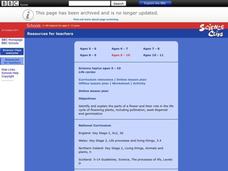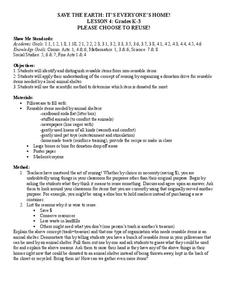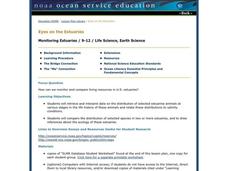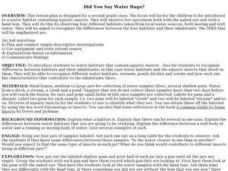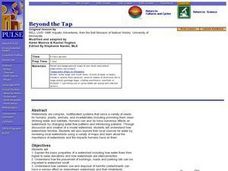Curated OER
Growing Plants
Students explore plants and recognize that they are living things that require light and water to grow. In this online plant biology lesson, students identify, name and match the parts of plants. Extension activities and suggested...
Curated OER
Pushes and Pulls
Learners examine different types of movement and causes that may affect those movements. In this online interactive forces and motion lesson, students use toy cars to observe push and pull and then make predictions and collect data...
Curated OER
Gases Around Us
Students investigate gases and liquids. For this states of matter online lesson, students examine how evaporation plays a part in the transition of liquids into gases as they watch a kettle of water boil and then work in small groups on...
Curated OER
Life Cycles
Students identify and explain the parts of a flower and their role in the life cycle of flowering plants. In this online plant biology lesson, students explore the processes of pollination, seed dispersal, and germination. Extension...
Curated OER
Health and Growth
Students identify healthy foods. In this nutrition lesson, students review the five food groups and categorize healthy and unhealthy foods on a chart. Students develop their own menus.
Curated OER
Characteristics of Materials
Students describe and compare common properties of various classroom materials. In this science/matter activity, students observe common classroom items and the materials they are made of to complete a list of common properties.
Curated OER
Micro-organisms
Learners discuss micro-organisms. In this micro-organisms lesson, students identify which micro-organisms are harmful and which ones are beneficial. Learners complete a worksheet which is included in the lesson.
Curated OER
Digging Up The Facts
Students research environmental issues. In this environmental lesson, students use the Internet to research an environmental problem and list ten facts about it. Students write a summary of facts.
Curated OER
Evergreens In Winter
In this identifying trees learning exercise, students learn to identify 8 winter trees by their shapes. Students cut out flashcards with the name of the tree and its shape in silhouette.
Curated OER
My Giving Tree
Middle schoolers identify native and invasive trees. In this ecology lesson, students survey trees in their schoolyard and identify the species. Middle schoolers adopt a native tree sprout and record the growth in a journal.
Curated OER
Save the Earth: It's Everyone's Home!
Students organize a donation drive based on the concept of reusing items for an animal shelter. In this reusing items lesson plan, students distinguish between reusable and non reusable items, have a donation drive, and use the...
Curated OER
Eyes on the Estuaries
Young scholars study estuaries and compare several ones in the U.S. In this estuary lesson plan students interpret data and compare the distribution of different species.
Curated OER
Text for Dictation: The Environment
In this dictation text worksheet, students take dictation from a selection using vocabulary concerning the environment.
Curated OER
Riparian Buffers
In this riparian buffer worksheet, students click on the links to learn about why we should maintain the riparian buffer and answer short answer questions about it. Students answer 7 questions.
Curated OER
The Water Cycle
When homeschooling parents and children tackle the water cycle, the results can be a fascinating exploration of our environment.
Curated OER
Water Quality Survey: Monitoring the Sustainability of Pigeon Creek
Students research the History of Pigeon Creek (or any watershed in your area). In this environmental science lesson, students conduct field tests such as pH and nitrates. They collect data and compare what they collected with other groups.
Curated OER
Did You Say Water Bugs?
Second graders observe live specimens of aquatic insects in a water habitat. They study specimens from both moving and still water with the naked eye and a hand lens.
Curated OER
Beyond the Tap
Students explain the basic properties of a watershed including how water flows from higher to lower elevations and how watersheds are interconnected. They comprehend how the placement of buildings, roads, and parking lots can be...
Curated OER
Invasive Species
Students use the Internet to research non-native plants that exist in their local community. Using this information, they analyze the invasive species effect on their environment. In groups, they plan and execute their own project to...
Curated OER
Coastal Development
Students examine how a coastal area changes after it has been developed. They discover the impact of development on the environment. They illustrate their own non-developed area and change it into a developed area.
Curated OER
Rubber Gardens
Students recycle discarded automobile tires and create gardening sites for limited space areas.
Curated OER
Ourselves
Learners use a website to name and compare external body parts of humans and other animals.
Curated OER
Sound and Hearing - Internet Research
Students use a website to help them recognize that sound is generated in a variety of ways and from different sources. They determine that sounds vary in tone and loudness, and learn there are different ways to describe sound.
Curated OER
Moving and Growing
Pupils know that humans and some other animals have bony skeletons inside their body. They know that other animals have skeletons on the outside of their bodies. They explain the role of both kinds of skeletons.





